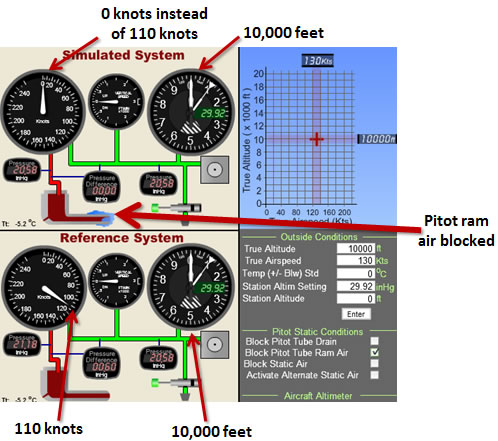|
2a. Ram air blocked, but static port and Pitot tube drain remain unobstructed.
If only the ram air port (opening) is blocked the airspeed indicator will go to zero. Both the altimeter and vertical speed indicator are not affected since they don't use the ram air pressure. If this port remains the only one blocked the zero indication will remain regardless of any altitude or airspeed change.

Fig 4-22 Pitot ram air blocked at an altitude of 10,000 feet and 130 knots true airspeed.
In figure 4-22 we have the aircraft flying at 10,000 feet and 130 knots true airspeed when the blockage occurs. The airspeed indicator which was showing 110 knots indicated airspeed before the blockage, now drops to zero. This is due to the difference in pressure between the Pitot tube chamber and the air in the static air line being 20.58 - 20.58 = 0 inHg which corresponds to a zero indicated airspeed (see chart 2-3). The reason for the pressure in the Pitot tube chamber being the same as the outside pressure, is that the Pitot tube drain allows air pressure to equalize with the outside air pressure. The reference system shows what would happen if the blockage did not occur. The correct reading on the airspeed indicator would be 110 knots because we have qc = PT - P = 21.18 - 20.58 = 0.60 inHg (see chart 2-3).

Fig 4-23 Aircraft descends 3000 feet and increases true airspeed by 50 knots.
In this example the aircraft then increases airspeed to 160 knots and descends to 7000 feet. As shown by the simulator (Fig 4-23), the indicated airspeed remains at zero. The pressure inside the Pitot tube chamber will be the same as the pressure outside the aircraft (23.09 inHg) because the drain opening will allow the pressure to equalize with the outside air. The difference in pressure between this chamber and the air in the static air line is 23.09 - 23.09 = 0 inHg which corresponds to a zero indicated airspeed (see chart 2-3). Therefore the airspeed indicator remains at zero even with altitude and airspeed change. The reference system shows that the correct reading on the airspeed indicator would be about 145 knots since we have qc = PT - P = 24.09 - 23.09 = 1.00 inHg (see chart 2-3).
Note that if the static air then becomes obstructed after the ram air port, the problem becomes scenario 1b. If the Pitot tube drain becomes obstructed as well after the ram air port, the problem becomes scenario 1e. If the static air is not obstructed Scenario 1b becomes scenario 2b when the Pitot tube drain becomes obstructed.
|

